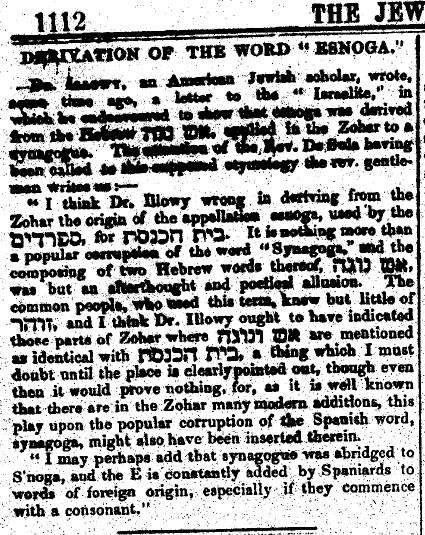Here's a letter to the Jewish Chronicle dated August 14, 1857 discussing the Hebrew Zoharic term אש נוגה ("bright fire"). Apparently pioneering American Orthodox rabbi Bernard Illowy had written a letter to Isaac Mayer Wise's Reform newspaper the Israelite which "endeavored to who that esnoga" - Spanish-Portuguese for "synagogue" - "was derived from the Hebrew אש נוגה, applied in the Zohar to a synagogue."
The respondent in the JC asked one of London's most distinguished Spanish-Portuguese scholars, the Rev. David Aaron de Sola about it, and he replied that he doesn't think Illowy is correct. Instead of Esnoga being derived from אש נוגה ,אש נוגה was derived from Esnoga. de Sola explained how Esnoga comes from Synagoga, and has a Spanish prefix. He explains that "the E is constantly added by Spaniards to words of foreign origin, especially if they commence without a consonant." He is quite correct, although evidently he didn't understand the reason why, which is that Spanish doesn't allow initial consonant clusters, so out of necessity a vowel prefix was added.
De Sola does not profess to be familiar with the Zohar, requesting that Illoway should show which places in the Zohar he means. However, he says that it is "well known that in the Zohar there are many modern additions" and that this could be one of them.
Not knowing the Zohar and not knowing the literature about its authenticity, de Sola was nonetheless able to detect one of Rabbi Jacob Emden's proofs that the Zohar contains late additions, much the same way any of us would if the word "shul" was used in the Zohar in a Hebrew play on words of some kind, and if someone had then suggested that our word was derived from that Hebrew expression. (Oh yeah? You have a better example? ;-)
See third chapter in Yaavetz's מטפחת ספרים here.

Unfortunately only isolated pages of the Israelite are online, so I wasn't able to find Dr. Illowy's original piece. However, the natural place to look is in his son Dr. Henry Illoway's compilation of his letters and responsa, the מלחמות אלהים (Berlin 1914), which includes polemics written to the Israelite. Not included. Since it must have been part of a polemic, I can't help wonder if it wasn't included because the son knew that his father's suggestion was in error.
As for whether Illowy himself had seen or was even aware of מטפחת ספרים - which was probably rare in 1857 having been only printed once 90 years earlier - or not, I can't say. It's possible he was aware of it and in his opinion deriving Esnoga from אש נוגה was the solution to the anachronism. It is interesting that he was a student at the Rabbinical Seminary of Padua for a short while, and presumably Shadal taught his theory of the Zohar's origin there. Below is from his Vikuach the published version of his arguments in 1852:






Why do you doubt even for a moment that De Sola was very, very familiar indeed with R. Jacob
ReplyDeleteEmden's work, especially the criticism directed against the Zohar, for which he was notoriously famous throughout the Jewish world! Even if De Sola himself was not so familiar with the Zohar, of course he knew the European polemic against it; in fact, the Zohar was probably deliberately left out of De Sola's education because of this very polemic against its authenticity! Illoway was one of the more learned congregants here at Congregation Shearith Israel (Spanish & Portuguese) and Bnai Jeshurun, which was at that time Orthodox. All of the Anglo Spanish & Portuguese as well as Ashkenazi congregations in coastal Western Europe and America were in close contact with each other. R. Jacob Emden's critique of the Zohar followed upon his father's work combatting lingering Sabbateanism, often by trying to find ways of excising kabbalah. R. Emden's father, the Haham Tzvi, had been prominent in both London and Amsterdam. De Sola's family was from Amsterdam, and there were prominent connections at that time with other European Sephardic congregations, as well, such as the Italian community of Livorno, from which Philadelphia Spanish & Portuguese later recruited a prominent leader, Sabato Morais, and Padua, a prominent university town, was probably very much "in the loop," as well. Many of these interconnected Spanish & Portuguese congregations, such as ours, tried to excise kabbalistic influences from the time of Shabbattai Tzvi on, and since that time, at least, we here in New York do not say the Zohar's Brikh Shmeh, for example.
Ira Rohde, Hazan, Cong. Shearith Israel (Spanish & Portuguese), New York
>Why do you doubt even for a moment that De Sola was very, very familiar indeed with R. Jacob Emden's work, especially the criticism directed against the Zohar, for which he was notoriously famous throughout the Jewish world
ReplyDeleteBecause he doesn't reference it, professes no knowledge of the Zohar or even that Esh Noga is in it. My guess is that Mitpachas Sefarim became a lot more famous after it was reprinted.
However, thank you for your insightful comment. I didn't mean to impugn de Sola in any way, if that's what you thought I was getting at. I know full well that he was very learned indeed.